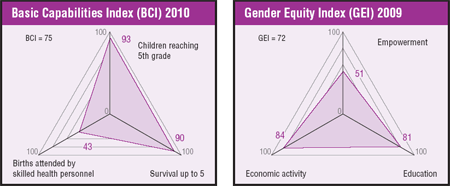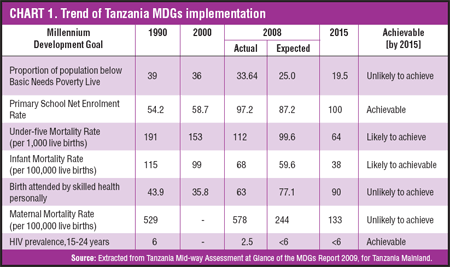MDGs: an under-funded crusade
SAHRiNGON Tanzania Chapter
Armando Swenya
Martina M. Kabisama
The efforts of the Government to improve the lives of Tanzanians have been in vain, primarily due to the lack of commitment on strategies both at the national and international levels: Official Development Assistance (ODA) disbursement is often late and does not go with the Tanzanian national budget process. Tanzania’s increasing external debt will delay much-needed steady economic growth. Although the economic indicators are heartening, the social ones – especially gender equality – reveal more efforts are needed to reach the MDGs.
 |
Tanzania has adopted several poverty reduction policies, including the Tanzania Development Vision 2025 (for Mainland), Vision 2020 (for Zanzibar), as well as the Millennium Development Goals (MDGs). To implement these, the Government announced the National Strategy for Growth and Reduction of Poverty, which seeks not only to promote growth and reduce poverty but also to enhance social well being, the quality of life, governance and accountability. However, the efforts of the Government to improve the lives of Tanzanians have been in vain, as the majority of the population survives on less than one dollar a day.
Limits of economic growth
Tanzania’s economy growth rate increased from 4.1% in 1998 to 7.4% in 2008; a fall to 5% was expected in 2009 due to the global economic crisis, before gradually increasing to 7.5% by 2012.[1] During the past five years, economic growth increased on average 7% a year, which since 2000 has outpaced the growth of labour and capital inputs (both below 2%),[2] reflecting a more efficient use of these resources owing to reforms and technology.
Tanzania is ranked 151 out of 182 countries on the 2009 Human Development Index (HDI), with per capital Gross Domestic Product (GDP) of about USD 1,150, but only USD 430 in nominal terms. Although agriculture represents only about 24% of GDP, some 75% of the population is employed in this sector.[3]
Tanzania has implemented a revolutionary agricultural policy, called “Kilimo Kwanza” (Agriculture first), which encourages modern methods of production. However, despite efforts to extend irrigation since 1967, so far only 1% of the 29 million hectares of arable land is irrigated. A second constraint concerns resources, which despite the Kilimo Kwanza policy has remained at 6.5% of the total budget of 9.5 trillion Tanzanian shillings (USD 6.4 billion) for 2009/2010.[4]
Inflation and debts hamper economic growth
Tanzania’s fiscal balance is within the acceptable limits although its performance is very dependent on donor aid. The public debt stands at around 25% of GDP and is considered sustainable after the debt write-offs in 2000, under the program of Highly Indebted Poor Countries Initiative.[5]
The budget allocation for recurrent and development expenditure has also been a problem. For fiscal year 2009, the Government allocated USD 6.4 billion, including USD 4.5 billion for recurrent expenditure and USD 1.9 billion for development expenditure, of which USD 1.3 billion – 78% – is dependent on external assistance.[6]
At the same time, the inflation rate quickly rose to 12.2%[7] as the prices of imported goods increased due to the fall of the external value of the shilling rate in 2008 and December 2009. The inflation rate for 2009 was expected to remain well below 10%, although this is higher than the target of 7% in line with the decrease in food prices.
According to the IMF, the Central Bank is moderately independent and has contained inflation as its prime target. However, the effects of interest rate hikes on the volume of credit to the private sector in particular are seriously taken into account. Private sector credit started from a very low base – at 9% of GDP in 2003 – but increased to almost 20% in 2008. Given the size of the debt, SAHRiNGON recommends the Government minimize recurrent expenditure in order to have a reliable economic base for the economic growth.
Challenges for ODA and MDGs
The Paris Declaration on Aid Effectiveness, endorsed by developing countries and donor partners in 2005, recognizes that aid effectiveness requires a global commitment to increase development assistance and urges a common search for more efficient ways of channeling aid in order to achieve desired development goals, including the MDGs.
Despite its commitment to the Paris Declaration, Tanzania’s external debt is still USD 5.5 billion, and this is increasing by about USD 500 million per year after the external debt cancellation in 2000.[8] Debt repayment amounts to only 1% to 2% of all long term debt, although there are substantial but decreasing principal and interest arrears amounting to over USD 1.2 billion with non-OECD countries like China and Arab States.
Tanzania has often been commended for its progress in improving aid management but nevertheless retains many features of a typically aid-dependent country. The budget for the fiscal year 2008-2009 reveals that foreign aid represents approximately 35% of its budget. In the fiscal year 2007-2008, Official Development Assistance (ODA) to Tanzania was USD 2 billion.[9] This money includes grants, debt relief and loans.
Aid management in Tanzania is guided by the Joint Assistance Strategy (JAST) developed by the Government and its donor partners. It receives development aid under three typical modalities: General Budget Support (GBS), Basket Funds (BFs) and direct project funds, with GBS being the preferred modality. However, a large proportion of aid continues to be delivered through the project modality, which in many instances are off-budget. Donors are being urged to shift away from projects towards programme based approaches, through the JAST framework.
A 2008 report by the Ministry of Finance and Economic Affairs indicated that the GBS and basket funding continue to perform well whilst project funds still pose challenges, including failure of sectoral ministries to account for project fund expenditures, funding delays and irregularities, since project fund disbursements depend on implementation progress, various prior actions, procedural requirements and in-year performance assessments.
Also there are no sanctions to donors when they fail to honor their promises of supporting developing countries. This situation seriously undermines the principle of mutual accountability, one of the five principles of the Paris Declaration.
SAHRiNGON Tanzania recommends donors provide aid to GBS because it is easier to hold up disbursements in the face of changing political circumstances. For example, the UK withheld £10 million (USD 14.3 million) from its fiscal year 2002 disbursement when it was disclosed that Tanzania intended to purchase a USD 40 million air traffic control system for military use.[10]
Declining external aid is another problem. Tanzania needs to receive USD 4 billion in 2010 in order to achieve the MDGs.[11] However, to meet this target the Government must agree to stringent aid conditionalities imposed by the IMF and World Bank. Bilateral donors provide aid resources for implementation of MDGs through sector wide programs.
 |
Gender equality: lights and shadows
A review of laws, strategies and policies to promote the MDGs and align them with principles of gender equality resulted in land laws that recognize equal rights between men and women, [12] labour laws that prohibit discrimination against women in work places, laws making female genital mutilation a crime and positive action policies to increase the number of women in politics and decision-making. [13]
However, several factors continue to impede women’s ability to realize their human rights. A number of discriminatory laws still remain, including Customary Law Declaration Order of 1963 which, among other things, prohibits widows from inheriting land from the deceased husband; and marriage laws that permit marriage for girls under 15 years old.[14]
Gender-based violence is another problem. Article 1 of the UN Declaration on the Elimination of Violence Against Women (1993) defines violence against women as “any act of gender-based violence that results in, or is likely to result in, physical, sexual, or psychological harm or suffering to women, including threats of such acts, coercion, or arbitrary deprivation of liberty, whether occurring in public or in private life.” However, Section 16 of the Tanzanian Law of Marriage provides that “no person has any right to inflict corporal punishment on his or her spouse.” This provision is narrow as it is limited to physical violence. SAHRiNGON suggests the amendment of this section to include all kind of gender-based violence.
Apart from the criminal justice framework,[15] economic dependency, resulting from limited opportunities for education and employment leaves women vulnerable to domestic violence.
The role of civil society
NGOs in Tanzania play a fundamental role in strengthening the capacity of civil society through informing and educating the public on various issues, including Government policies and development assistance. However, their ability to advance progress towards MDGs goals is affected by lack of funding from the Government and the donor community. The Government has made no commitment to funding for Civil Society Organizations (CSOs), which are not mentioned in national policies for the implementation of the MDGs. In order to enhance the national realization of the MDGs, SAHRiNGON Tanzania recommends streamlining CSOs into MDGs policy and strategies.
[2] Leenderl Coljin, “Country Report – Tanzania,” Economic Research Department, Rabobank Nederland, February 2009. Available from: <www.overons.rabobank.com/content/images/Tanzania09_tcm64-82340.pdf>.
[3] HDI rose by only 1.15 a year between 1990 (0.436) and 2007/9 (0.530). UNDP, Human Development Report 2009, 63, 64, 73 and 116.
[4] Statement by Minister of Finance and Economic Affairs Mustafa Haidi Mkulo introducing estimated revenue and expenditure for financial year 2009/10. Dodoma, 11 June 2009, 73. Available
[5] Ministry of Finance and Economic Affairs, Economic Survey 2008, Dar es Salaam, 2009.
[6] Ibid. 73, 74.
[7] National Bureau of Statistics and Bank of Tanzania. See: <www.bot-tz.org/Publications/ inflationDevelopments.htm> (accessed on 16 March 2010).
[8] Ministry of Finance and Economic Affairs, Quarterly Public Debt Report, September 2009.
[9] Overview of Aid in Tanzania, Development Partners Group – Tanzania. Available from: <www.tzdpg.or.tz/external/dpg-tanzania/overview-of-aid-in-tanzania.html> (accessed on 17 March 2010).
[10] Brian Frantz, “General Budget Support in Tanzania: A Snapshot of Its Effectiveness,” 3 April 2004. Available from: <www.sarpn.org.za/documents/d0001036/P1149-PNADA029_Tanzania_April2004.pdf>.
[11] Tanzania Millennium Development Goals Report – Mid way Evaluation Report 2000-2008.
[12] Laws of Tanzania, 2002 rev. ed, cap. 114, 115.
[13] Employment and Labour Relations Act, Act No. 6 of 2006.
[14] Laws of Tanzania, op. cit., Law of Marriage Act, Section 13, cap 29.
[15] “Crime and the Criminal Justice System: Tanzania Country Review Report Enhancing the Delivery of Security in Africa,” Institute of Security Studies (ISS-South Africa) and African Human Security Initiative (AHSI), 2009.


